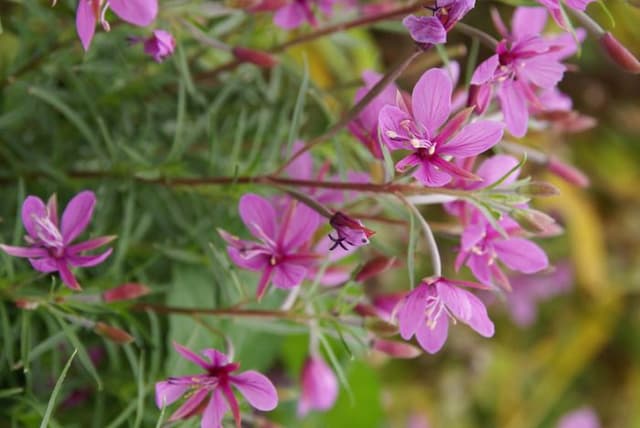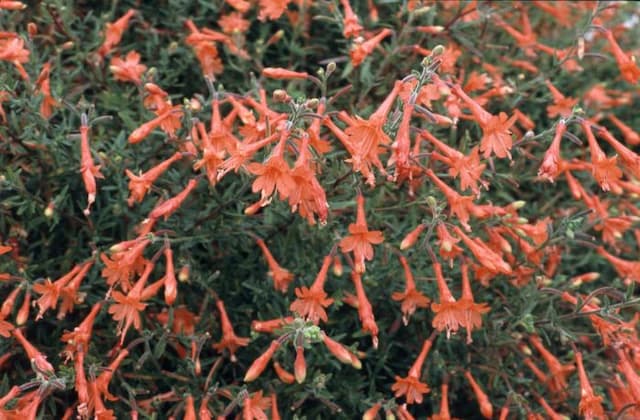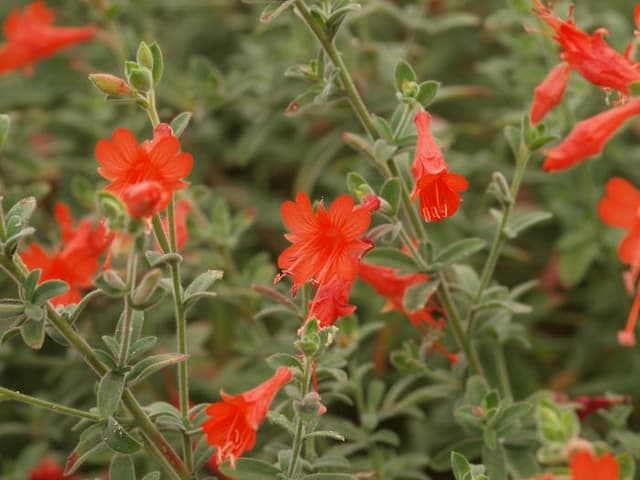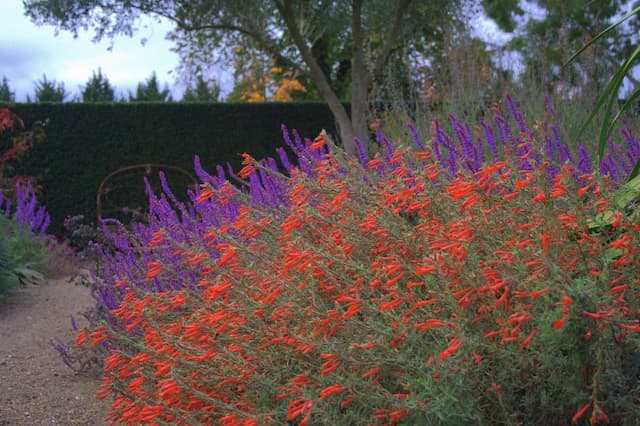Fuchsia Fuchsia 'Linda Hinchliffe'

ABOUT
The Fuchsia 'Linda Hinchliffe' is a showy garden plant known for its striking and pendulous teardrop-shaped flowers. These flowers are a unique combination of colors, typically featuring a pink or purple outer layer with a contrasting paler or sometimes white inner layer, creating an elegant two-toned effect. Each flower hangs gracefully from the stems, with long, delicate stamens extending from beneath the petals, adding to the overall ornamental appearance. The foliage of the Fuchsia 'Linda Hinchliffe' is comprised of lush green leaves that are somewhat elongated with a soft texture, providing a verdant backdrop that makes the vibrant blooms stand out even more. The contrast between the leaves and the flowers offers a compelling display, making this plant a favorite among gardeners who wish to add a splash of color to their outdoor space. The leaves may show a slight serration along their edges, contributing a subtle texture to the plant's profile. Overall, the Fuchsia 'Linda Hinchliffe' presents a striking visual impact with its dangling blossoms, rich colors, and full foliage. It's a popular choice for hanging baskets and container planting, where its trailing growth and abundant blossoms can be showcased to stunning effect. Additionally, its generous flowering habit ensures a long-lasting display of colour, often from early summer until the first frosts, making it a valuable addition to any garden seeking continuous visual interest.
About this plant
 Names
NamesFamily
Onagraceae
Synonyms
Lady's Eardrops
Common names
Fuchsia 'Linda Hinchliffe'.
 Toxicity
ToxicityTo humans
Fuchsia, including the 'Linda Hinchliffe' variety, is generally considered non-toxic to humans. Ingesting parts of the plant, such as flowers or berries, is typically not harmful. However, some people may have a sensitivity or allergic reaction to fuchsias. In such cases, symptoms could include gastrointestinal discomfort, nausea, vomiting, or diarrhea, but these are not common.
To pets
Fuchsia, including the 'Linda Hinchliffe' variety, is generally considered non-toxic to pets. It is not commonly associated with poisoning in cats, dogs, or other domestic animals. However, as with humans, some pets may have a sensitivity to fuchsias that could cause mild gastrointestinal upset if ingested. Symptoms might include vomiting or diarrhea, but serious toxicity is unlikely.
 Characteristics
CharacteristicsLife cycle
Perennials
Foliage type
Deciduous
Color of leaves
Green
Flower color
Mixed
Height
1-2 feet (30-60 cm)
Spread
1-2 feet (30-60 cm)
Plant type
Shrub
Hardiness zones
9
Native area
Central America
Benefits
 General Benefits
General Benefits- Ornamental Appeal: Fuchsia 'Linda Hinchliffe' is highly valued for its attractive and unique pendant-shaped flowers, which can add a splash of color to gardens and indoor spaces.
- Pollinator Attraction: The flowers of the fuchsia are known to attract hummingbirds and butterflies, which can aid in the pollination of nearby plants.
- Shade Tolerance: This plant can tolerate partial shade, making it a versatile choice for gardeners with shaded areas.
- Long Blooming Season: Fuchsia 'Linda Hinchliffe' often has a prolonged blooming period that lasts from spring to fall, providing extended visual interest.
- Container Planting: This variety of fuchsia is suitable for container planting, allowing those with limited space to enjoy its beauty.
- Easy Propagation: Fuchsias can be easily propagated from cuttings, which allows gardeners to create new plants for free.
- Versatility in Landscape: They can be used in various landscape designs, including hanging baskets, borders, and as a focal point in a garden setting.
 Medical Properties
Medical PropertiesThis plant is not used for medical purposes.
 Air-purifying Qualities
Air-purifying QualitiesThis plant is not specifically known for air purifying qualities.
 Other Uses
Other Uses- As a natural dye: The flowers of the Fuchsia can be used to produce a beautiful pink-purple dye for coloring fabrics or artwork.
- Edible decoration: The blooms of the Fuchsia are edible and can be used to add a pop of color to salads, desserts, or as a garnish for cocktails and drinks.
- Insect attraction: Fuchsias can be planted to attract hummingbirds, bees, and other pollinators to your garden, aiding in the pollination of nearby plants.
- Bonsai: With their graceful branches and striking flowers, Fuchsias like 'Linda Hinchliffe' can be trained as bonsai for an artistic display indoors or in miniature gardens.
- Crafting botanical prints: The leaves and flowers of Fuchsias can be used to create detailed botanical prints on paper or fabric through various print-making techniques.
- Photography subject: The distinctive flowers of the Fuchsia make it an excellent subject for photographers interested in capturing floral beauty and garden wildlife like insects.
- Education: Fuchsias can be used in educational settings, such as schools and botanical gardens, to teach about plant biology and hybridization.
- Cold composting: Fuchsia plant material can be added to a compost pile, especially in a cold composting method where it decomposes over time to add nutrients back into the soil.
- Culinary experiments: Some chefs use Fuchsia flowers to create novel dishes or to infuse vinegars and syrups with their subtle flavors.
- Thematic gardening: Fuchsias can be included in "Victorian" themed gardens or fairy gardens due to their vintage appeal and whimsical flower shapes.
Interesting Facts
 Feng Shui
Feng ShuiThe Fuchsia is not used in Feng Shui practice.
 Zodiac Sign Compitability
Zodiac Sign CompitabilityThe Fuchsia is not used in astrology practice.
 Plant Symbolism
Plant Symbolism- Beauty: Fuchsia plants, with their striking two-toned flowers, are often associated with beauty and elegance, symbolizing a delicate attractiveness.
- Gentility: The graceful drooping of a fuchsia's blossoms can signify good taste, refinement, and a gentle nature.
- Confiding Love: In the language of flowers, fuchsias can represent trust and confiding love, suggesting a deep bond between individuals.
- Vibrancy: The rich colors and lively appearance of the fuchsia plant often symbolize a vibrant energy or exuberance.
- Warning: Some interpret the fuchsia's vivid colors as a warning of sorts, maybe alluding to a bold personality or a hint of caution.
- Inconstancy: Victorian symbolism sometimes considered the fuchsia as representing inconstancy, perhaps due to the way the flowers hang uncertainly from the stems.
 Water
WaterFuchsia plants, including the 'Linda Hinchliffe' variety, prefer consistently moist soil, so water them when the top inch of soil feels dry to the touch. Depending on the environment, this might be twice a week or more. The method should be gentle, avoiding wetting the foliage, which can encourage disease. Each watering session should thoroughly soak the soil until water runs out of the bottom of the pot, indicating that the root zone has received adequate moisture. Ensure proper drainage to prevent waterlogging, and reduce watering in the winter months when plant growth slows down. As a guideline, a fuchsia hanging in a 12-inch basket may need 2-3 gallons of water per week during hot summer months.
 Light
LightFuchsia 'Linda Hinchliffe' thrives best in bright, indirect light or filtered sunlight. It should be placed in a spot where it is shielded from the harsh midday sun, which can scorch its leaves. An ideal spot would be a location that gets morning sunlight and afternoon shade, or dappled light throughout the day. Avoid deep shade, as this can lead to weak growth and fewer flowers.
 Temperature
TemperatureThe Fuchsia 'Linda Hinchliffe' performs well in a temperature range between 55°F and 75°F, which is ideal for vigorous growth and flowering. Ensure that the temperature does not drop below 50°F, as fuchsias are sensitive to cold. The plant can survive brief periods of higher temperatures, but sustained heat above 80°F can stress the plant and cause wilting or leaf drop.
 Pruning
PruningPrune Fuchsia 'Linda Hinchliffe' to maintain its shape, encourage bushier growth, and remove dead or disease foliage. The best time to prune is in late winter or early spring, before new growth begins. Pinch out the tips of stems after the first few sets of leaves to promote branching. Pruning can be done periodically throughout the growing season as needed to remove faded flowers and seed pods, which helps encourage further blooming.
 Cleaning
CleaningAs needed
 Soil
SoilFuchsia 'Linda Hinchliffe' prefers a well-draining soil mix with a pH between 6 and 7. A mixture of peat, perlite, and loam works well. Ensuring good drainage is crucial to avoid root rot, and incorporating organic matter like compost will help maintain soil fertility.
 Repotting
RepottingFuchsia 'Linda Hinchliffe' should be repotted annually to ensure continued growth. It is best to repot in the spring, using fresh potting mix to replenish nutrients and provide room for root expansion. Care should be taken not to disturb the roots excessively during the process.
 Humidity & Misting
Humidity & MistingFuchsia 'Linda Hinchliffe' thrives in moderate to high humidity levels, ideally between 60-70%. If the air is too dry, particularly indoors, use a humidity tray or a room humidifier to increase moisture levels around the plant's environment.
 Suitable locations
Suitable locationsIndoor
Keep in bright, indirect light and maintain high humidity.
Outdoor
Place in partial shade and shelter from strong winds.
Hardiness zone
10-11 USDA
 Life cycle
Life cycleThe Fuchsia 'Linda Hinchliffe', commonly known as hardy fuchsia, begins its life cycle as a seed, which germinates in moist, well-drained soil in a cool, shaded environment. As the seedling emerges, it develops into a young plant with characteristic teardrop-shaped leaves and begins to form a bushy habit. Through its vegetative stage, the plant grows and matures, producing more leaves and stems, and it can be encouraged to branch out through pruning. During its reproductive stage, typically in late spring to autumn, it bears its distinctive hanging flowers, which are purple and pink in color, attracting pollinators such as bees and hummingbirds. Following pollination, the flowers develop into small, dark-colored berries, which are actually fleshy fruits containing seeds for the next generation of plants. In regions with colder winters, the fuchsia may die back to the ground, entering a period of dormancy, but it can resprout from the roots the following spring if properly mulched and protected.
 Propogation
PropogationPropogation time
Spring-Early Summer
The Fuchsia 'Linda Hinchliffe', also known by its common name as fuchsia, is best propagated through softwood cuttings taken in late spring or early summer when the plant's growth is most vibrant. To propagate fuchsias using this method, one must select a healthy stem that has not yet flowered and cut a 4-6 inch (approximately 10-15 cm) length, ensuring there are several leaf nodes on the cutting. The lower leaves should be removed, and the cut end of the stem can be dipped in rooting hormone to encourage root development. The prepared cutting is then placed in a well-draining potting mix, ensuring at least two to three nodes are buried beneath the soil surface. The pot should be kept in a warm environment with indirect light and maintained with consistent humidity by covering it with a plastic bag or placing it in a mini greenhouse until roots have developed, usually within a few weeks. Regularly checking for root growth and gradually acclimatizing the new plant to less humid conditions is crucial before transplanting it outside.









